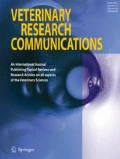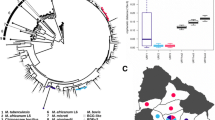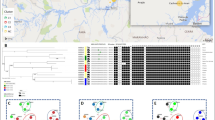Abstract
Single nucleotide polymorphisms (SNPs) calculated from whole genome sequencing (WGS) are ideally suited to study evolutionary relationships of pathogens and their epidemiology. Mycobacterium caprae infections have been documented frequently in cattle and red deer along the Bavarian and Austrian Alps during the last decade. However, little is still known about the transmission within cattle holdings and possible alterations of the genomes of M. caprae during such events. The aim of this study was to study the molecular epidemiology of bovine tuberculosis (bTB) in selected herds based on isolate-specific genome-wide SNPs and to perform a phylogenetic network analysis. In total, 61 M. caprae isolates were collected originating from eight cattle farms over a period of twelve years between 2004 and 2015. Analysis of their sequence data revealed that the M. caprae isolates of an affected farm differ at all in a few SNPs. In contrast, many more SNPs were found when comparing the M. caprae genomes originating from different herds. The results demonstrated that the spread of bTB in the affected farms occurred by direct transmission between the members of each herd rather than between herds and a M. caprae introduction in farms after contact events e. g. on summer pastures can readily be traced by WGS analysis. Furthermore, we assembled a nearly complete whole genome sequence of M. caprae derived from several cattle isolates originating from bTB cases in the Bavarian Alpine region.




Similar content being viewed by others
References
Abecasis GR, Altshuler D, Auton A, Brooks LD, Durbin RM, Gibbs RA, Hurles ME, McVean GA (2010) A map of human genome variation from population-scale sequencing. Nature 467(7319):1061–1073. doi:10.1038/nature09534
Alam I, Antunes A, Kamau AA, Ba alawi W, Kalkatawi M, Stingl U, Bajic VB, Hernandez-Lemus E (2013) INDIGO – INtegrated data warehouse of MIcrobial GenOmes with examples from the Red Sea extremophiles. PLoS One 8(12):e82210. doi:10.1371/journal.pone.0082210
Aranaz A, Cousins D, Mateos A, Domínguez L (2003) Elevation of Mycobacterium tuberculosis subsp. caprae Aranaz et al. 1999 to species rank as Mycobacterium caprae comb. Nov., sp. nov. Int J Syst Evol Microbiol 53(Pt 6):1785–1789. doi:10.1099/ijs.0.02532-0
Bandelt HJ, Forster P, Röhl A (1999) Median-joining networks for inferring intraspecific phylogenies. Mol Biol Evol 16(1):37–48
Barlow ND, Kean JM, Hickling G, Livingstone PG, Robson AB (1997) A simulation model for the spread of bovine tuberculosis within New Zealand cattle herds. Prev Vet Med 32(1–2):57–75. doi:10.1016/S0167-5877(97)00002-0
Biek R, O'Hare A, Wright D, Mallon T, McCormick C, Orton RJ, McDowell S, Trewby H, Skuce RA, Kao RR (2012) Whole genome sequencing reveals local transmission patterns of Mycobacterium bovis in sympatric cattle and badger populations. PLoS Pathog 8(11):e1003008. doi:10.1371/journal.ppat.1003008
Brooks-Pollock E, Roberts GO, Keeling MJ (2014) A dynamic model of bovine tuberculosis spread and control in great Britain. Nature 511(7508):228–231. doi:10.1038/nature13529
Bryant JM, Harris SR, Parkhill J, Dawson R, Diacon AH, van Helden P, Pym A, Mahayiddin AA, Chuchottaworn C, Sanne IM, Louw C, Boeree MJ, Hoelscher M, McHugh TD, Bateson ALC, Hunt RD, Mwaigwisya S, Wright L, Gillespie SH, Bentley SD (2013a) Whole-genome sequencing to establish relapse or re-infection with Mycobacterium tuberculosis: a retrospective observational study. Lancet Respir Med 1(10):786–792. doi:10.1016/S2213-2600(13)70231-5
Bryant JM, Schurch AC, van Deutekom H, Harris SR, de Beer JL, de Jager V, Kremer K, van Hijum SA, Siezen RJ, Borgdorff M, Bentley SD, Parkhill J, van Soolingen D (2013b) Inferring patient to patient transmission of Mycobacterium tuberculosis from whole genome sequencing data. BMC Infect Dis 13:110. doi:10.1186/1471-2334-13-110
Carver T, Harris SR, Berriman M, Parkhill J, McQuillan JA (2012) Artemis: an integrated platform for visualization and analysis of high-throughput sequence-based experimental data. Bioinformatics 28(4):464–469. doi:10.1093/bioinformatics/btr703
Cole ST, Brosch R, Parkhill J, Garnier T, Churcher C, Harris D, Gordon SV, Eiglmeier K, Gas S, Barry CE, Tekaia F, Badcock K, Basham D, Brown D, Chillingworth T, Connor R, Davies R, Devlin K, Feltwell T, Gentles S, Hamlin N, Holroyd S, Hornsby T, Jagels K, Krogh A, McLean J, Moule S, Murphy L, Oliver K, Osborne J, Quail MA, Rajandream MA, Rogers J, Rutter S, Seeger K, Skelton J, Squares R, Squares S, Sulston JE, Taylor K, Whitehead S, Barrell BG (1998) Deciphering the biology of Mycobacterium tuberculosis from the complete genome sequence. Nature 393(6685):537–544. doi:10.1038/31159
Comas I, Coscolla M, Luo T, Borrell S, Holt KE, Kato-Maeda M, Parkhill J, Malla B, Berg S, Thwaites G, Yeboah-Manu D, Bothamley G, Mei J, Wei L, Bentley S, Harris SR, Niemann S, Diel R, Aseffa A, Gao Q, Young D, Gagneux S (2013) Out-of-Africa migration and Neolithic coexpansion of Mycobacterium tuberculosis with modern humans. Nat Genet 45(10):1176–1182. doi:10.1038/ng.2744
Conlan AJK, McKinley TJ, Karolemeas K, Pollock EB, Goodchild AV, Mitchell AP, Birch CPD, Clifton-Hadley RS, Wood JLN (2012) Estimating the hidden burden of bovine tuberculosis in great Britain. PLoS Comput Biol 8(10):e1002730. doi:10.1371/journal.pcbi.1002730
Copin R, Coscollá M, Seiffert SN, Bothamley G, Sutherland J, Mbayo G, Gagneux S, Ernst JD (2014) Sequence diversity in the pe_pgrs genes of Mycobacterium tuberculosis is independent of human T cell recognition. MBio 5(1):13. doi:10.1128/mBio.00960-13
de La Fuente J, Díez-Delgado I, Contreras M, Vicente J, Cabezas-Cruz A, Manrique M, Tobes R, López V, Romero B, Domínguez L, Garrido JM, Juste R, Gortazar C (2015) Complete genome sequences of field isolates of Mycobacterium bovis and Mycobacterium caprae. Genome Announc 3(3). doi:10.1128/genomeA.00247-15
de La Rua-Domenech R, Goodchild AT, Vordermeier HM, Hewinson RG, Christiansen KH, Clifton-Hadley RS (2006) Ante mortem diagnosis of tuberculosis in cattle: a review of the tuberculin tests, gamma-interferon assay and other ancillary diagnostic techniques. Res Vet Sci 81(2):190–210. doi:10.1016/j.rvsc.2005.11.005
DePristo MA, Banks E, Poplin R, Garimella KV, Maguire JR, Hartl C, Philippakis AA, del Angel G, Rivas MA, Hanna M, McKenna A, Fennell TJ, Kernytsky AM, Sivachenko AY, Cibulskis K, Gabriel SB, Altshuler D, Daly MJ (2011) A framework for variation discovery and genotyping using next-generation DNA sequencing data. Nat Genet 43(5):491–498. doi:10.1038/ng.806
Domogalla J, Prodinger WM, Blum H, Krebs S, Gellert S, Müller M, Neuendorf E, Sedlmaier F, Büttner M (2013) Region of difference 4 in alpine Mycobacterium caprae isolates indicates three variants. J Clin Microbiol 51(5):1381–1388. doi:10.1128/JCM.02966-12
Eisenberg T, Nesseler A, Sauerwald C, Kling U, Riße K, Kaim U, Althoff G, Fiege N, Schlez K, Hamann H-P, Fawzy A, Moser I, Riße R, Kraft G, Zschöck M, Menge C (2015) Mycobacterium tuberculosis exposure of livestock in a German dairy farm: implications for intra vitam diagnosis of bovine tuberculosis in an officially tuberculosis-free country. Epidemiol Infect:1–8. doi:10.1017/S0950268815001995
European Commission (1996) 97/76/EC: Commission Decision of 17 December 1996 laying down the methods of control for maintaining the officially tuberculosis free status of bovine herds in certain Member States and regions of Member States (Text with EEA relevance). CELEX number: 31997D0076. Official Journal L 019, 22/01/1997:34–36
Ewing B, Green P (1998) Base-calling of automated sequencer traces using Phred II error probabilities. Genome Res 8(3):186–194. doi:10.1101/gr.8.3.186
Ewing B, Hillier L, Wendl MC, Green P (1998) Base-calling of automated sequencer traces UsingPhred I. Accuracy assessment. Genome Res 8(3):175–185. doi:10.1101/gr.8.3.175
Federal Research Institute for Animal Health (2016) Official collection of methods for the sampling and investigation of materials of animal origin for notifiable animal diseases (method collection). pp. 1–22. https://openagrar.bmel-forschung.de/receive/openagrar_mods_00005698
Fink M, Schleicher C, Gonano M, Prodinger WM, Pacciarini M, Glawischnig W, Ryser-Degiorgis M-P, Walzer C, Stalder GL, Lombardo D, Schobesberger H, Winter P, Büttner M (2015) Red deer as maintenance host for bovine tuberculosis, alpine region. Emerg Infect Dis 21(3):464–467. doi:10.3201/eid2103.141119
Fischer EAJ, van Roermund HJW, Hemerik L, van Asseldonk MAPM, de Jong MCM (2005) Evaluation of surveillance strategies for bovine tuberculosis (Mycobacterium bovis) using an individual based epidemiological model. Prev Vet Med 67(4):283–301. doi:10.1016/j.prevetmed.2004.12.002
Gardy JL, Johnston JC, Ho Sui SJ, Cook VJ, Shah L, Brodkin E, Rempel S, Moore R, Zhao Y, Holt R, Varhol R, Birol I, Lem M, Sharma MK, Elwood K, Jones SJM, Brinkman FSL, Brunham RC, Tang P (2011) Whole-genome sequencing and social-network analysis of a tuberculosis outbreak. N Engl J Med 364(8):730–739. doi:10.1056/NEJMoa1003176
Gilbert M, Mitchell A, Bourn D, Mawdsley J, Clifton-Hadley R, Wint W (2005) Cattle movements and bovine tuberculosis in great Britain. Nature 435(7041):491–496. doi:10.1038/nature03548
Goodchild AV, Clifton-Hadley RS (2001) Cattle-to-cattle transmission of Mycobacterium bovis. Tuberculosis (Edinb) 81(1–2):23–41. doi:10.1054/tube.2000.0256
Groenen PM, Bunschoten AE, van Soolingen D, van Embden JD (1993) Nature of DNA polymorphism in the direct repeat cluster of Mycobacterium tuberculosis; application for strain differentiation by a novel typing method. Mol Microbiol 10(5):1057–1065
Guerra-Assunção JA, Crampin AC, Houben R, Mzembe T, Mallard K, Coll F, Khan P, Banda L, Chiwaya A, Pereira RP, McNerney R, Fine PE, Parkhill J, Clark TG, Glynn, JR (2015) Large-scale whole genome sequencing of M. tuberculosis provides insights into transmission in a high prevalence area. eLife 4:110. doi: 10.7554/eLife.05166
Hall LMC (2006) Hypermutable bacteria isolated from humans - a critical analysis. Microbiology 152(9):2505–2514. doi:10.1099/mic.0.29079-0
Henkle E, Winthrop KL (2015) Nontuberculous mycobacteria infections in immunosuppressed hosts. Clin Chest Med 36(1):91–99. doi:10.1016/j.ccm.2014.11.002
Hermans PW, van Soolingen D, Bik EM, de Haas PE, Dale JW, van Embden JD (1991) Insertion element IS987 from Mycobacterium bovis BCG is located in a hot-spot integration region for insertion elements in Mycobacterium tuberculosis complex strains. Infect Immun 59(8):2695–2705
Hershberg R, Lipatov M, Small PM, Sheffer H, Niemann S, Homolka S, Roach JC, Kremer K, Petrov DA, Feldman MW, Gagneux S, Blaser MJ (2008) High functional diversity in Mycobacterium tuberculosis driven by genetic drift and human demography. PLoS Biol 6(12):e311. doi:10.1371/journal.pbio.0060311
Humblet MF, Boschiroli ML, Saegerman C (2009) Classification of worldwide bovine tuberculosis risk factors in cattle: a stratified approach. Vet Res 40(5). doi:10.1051/vetres/2009033
James BW, Williams A, Marsh PD (2000) The physiology and pathogenicity of Mycobacterium tuberculosis grown under controlled conditions in a defined medium. J Appl Microbiol 88(4):669–677. doi:10.1046/j.1365-2672.2000.01020.x
Jarzembowski, Young (2008) Nontuberculous Mycobacterial Infections. Archives of Pathology & Laboratory Medicine (No. 8):1333–1341
Johnston WT, Gettinby G, Cox DR, Donnelly CA, Bourne J, Clifton-Hadley R, Le Fevre AM, McInerney JP, Mitchell A, Morrison WI, Woodroffe R (2005) Herd-level risk factors associated with tuberculosis breakdowns among cattle herds in England before the 2001 foot-and-mouth disease epidemic. Biol Lett 1(1):53–56. doi:10.1098/rsbl.2004.0249
Kalkatawi M, Alam I, Bajic VB (2015) BEACON: automated tool for bacterial GEnome annotation ComparisON. BMC Genomics 16(1):493. doi:10.1186/s12864-015-1826-4
Kamerbeek J, Schouls L, Kolk A, van Agterveld M, van Soolingen D, Kuijper S, Bunschoten A, Molhuizen H, Shaw R, Goyal M, van Embden J (1997) Simultaneous detection and strain differentiation of Mycobacterium tuberculosis for diagnosis and epidemiology. J Clin Microbiol 35(4):907–914
King HC, Murphy A, James P, Travis E, Porter D, Hung YJ, Sawyer J, Cork J, Delahay RJ, Gaze W, Courtenay O, Wellington EM (2015) The variability and seasonality of the environmental reservoir of Mycobacterium Bovis shed by wild European badgers. Sci Report 5:12318. doi:10.1038/srep12318
Koressaar T, Remm M (2007) Enhancements and modifications of primer design program Primer3. Bioinformatics 23(10):1289–1291. doi:10.1093/bioinformatics/btm091
Lin S-H, Liao Y-C, Watson M (2013) CISA: contig integrator for sequence assembly of bacterial genomes. PLoS One 8(3):e60843. doi:10.1371/journal.pone.0060843
Magdalena J, Supply P, Locht C (1998) Specific differentiation between Mycobacterium bovis BCG and virulent strains of the Mycobacterium tuberculosis complex. J Clin Microbiol 36(9):2471–2476
Namouchi A, Didelot X, Schöck U, Gicquel B, Rocha EPC (2012) After the bottleneck: genome-wide diversification of the Mycobacterium tuberculosis complex by mutation, recombination, and natural selection. Genome Res 22(4):721–734. doi:10.1101/gr.129544.111
O'brien DJ, Schmitt SM, Fitzgerald SD, Berry DE, Hickling GJ (2006) Managing the wildlife reservoir of Mycobacterium bovis: the Michigan, USA, experience. Vet Microbiol 112(2–4):313–323. doi:10.1016/j.vetmic.2005.11.014
OIE - World Organisation for Animal Health (2012) Manual of diagnostic tests and vaccines for terrestrial animals, 7.ed. OIE, Paris
Otto TD, Dillon GP, Degrave WS, Berriman M (2011) RATT: rapid annotation transfer tool. Nucleic Acids Res 39(9):e57–e57. doi:10.1093/nar/gkq1268
Palisson A, Courcoul A, Durand B, Cunha MV (2016) Role of cattle movements in bovine tuberculosis spread in France between 2005 and 2014. PLoS One 11(3):e0152578. doi:10.1371/journal.pone.0152578
Pérez-Lago L, Comas I, Navarro Y, González-Candelas F, Herranz M, Bouza E, García-de-Viedma D (2014) Whole genome sequencing analysis of intrapatient microevolution in Mycobacterium tuberculosis: potential impact on the inference of tuberculosis transmission. J Infect Dis 209(1):98–108. doi:10.1093/infdis/jit439
Periwal V, Patowary A, Vellarikkal SK, Gupta A, Singh M, Mittal A, Jeyapaul S, Chauhan RK, Singh AV, Singh PK, Garg P, Katoch VM, Katoch K, Chauhan DS, Sivasubbu S, Scaria V (2015) Comparative whole-genome analysis of clinical isolates reveals characteristic architecture of Mycobacterium tuberculosis pangenome. PLoS One 10(4):e0122979. doi:10.1371/journal.pone.0122979
Phillips C, Foster C, Morris P, Teverson R (2003) The transmission of Mycobacterium bovis infection to cattle. Res Vet Sci 74(1):1–15. doi:10.1016/S0034-5288(02)00145-5
Price MN, Dehal PS, Arkin AP (2010) FastTree 2--approximately maximum-likelihood trees for large alignments. PLoS One 5(3):e9490. doi:10.1371/journal.pone.0009490
Prodinger WM, Brandstatter A, Naumann L, Pacciarini M, Kubica T, Boschiroli ML, Aranaz A, Nagy G, Cvetnic Z, Ocepek M, Skrypnyk A, Erler W, Niemann S, Pavlik I, Moser I (2005) Characterization of Mycobacterium caprae isolates from Europe by mycobacterial interspersed repetitive unit genotyping. J Clin Microbiol 43(10):4984–4992. doi:10.1128/JCM.43.10.4984-4992.2005
Prodinger WM, Indra A, Koksalan OK, Kilicaslan Z, Richter E (2014) Mycobacterium caprae infection in humans. Expert Rev Anti-Infect Ther 12(12):1501–1513. doi:10.1586/14787210.2014.974560
Rettinger A, Broeckl S, Fink M, Prodinger WM, Blum H, Krebs S, Domogalla J, Just F, Gellert S, Straubinger RK, Büttner M (2015) The region of difference four is a robust genetic marker for subtyping Mycobacterium caprae isolates and is linked to spatial distribution of three subtypes. Transbound Emerg Dis. doi:10.1111/tbed.12438
Rhyan JC, Spraker TR (2010) Emergence of diseases from wildlife reservoirs. Vet Pathol 47(1):34–39. doi:10.1177/0300985809354466
Rutherford K, Parkhill J, Crook J, Horsnell T, Rice P, Rajandream M-A, Barrell B (2000) Artemis: sequence visualization and annotation. Bioinformatics 16(10):944–945. doi:10.1093/bioinformatics/16.10.944
Schellner H (1956) Risk of infection incattle grazing pastures contaminated with tubercle bacilli. Rindertuberkulose 5 1956(5):179–188
Schoepf K, Prodinger WM, Glawischnig W, Hofer E, Revilla-Fernandez S, Hofrichter J, Fritz J, Köfer J, Schmoll F (2012) A two-Years' survey on the prevalence of tuberculosis caused by Mycobacterium caprae in red deer (Cervus elaphus) in the Tyrol, Austria. ISRN Vet Sci 2012(15):1–7. doi:10.5402/2012/245138
Seemann T (2014) Prokka: rapid prokaryotic genome annotation. Bioinformatics 30(14):2068–2069. doi:10.1093/bioinformatics/btu153
Stein RA (2011) Super-spreaders in infectious diseases. Int J Infect Dis 15(8):e510–e513. doi:10.1016/j.ijid.2010.06.020
Stucki D, Ballif M, Bodmer T, Coscolla M, Maurer A-M, Droz S, Butz C, Borrell S, Längle C, Feldmann J, Furrer H, Mordasini C, Helbling P, Rieder HL, Egger M, Gagneux S, Fenner L (2015) Tracking a tuberculosis outbreak over 21 years: strain-specific single-nucleotide polymorphism typing combined with targeted whole-genome sequencing. J Infect Dis 211(8):1306–1316. doi:10.1093/infdis/jiu601
Supply P, Lesjean S, Savine E, Kremer K, van Soolingen D, Locht C (2001) Automated high-throughput genotyping for study of global epidemiology of Mycobacterium tuberculosis based on mycobacterial interspersed repetitive units. J Clin Microbiol 39(10):3563–3571. doi:10.1128/JCM.39.10.3563-3571.2001
Swain MT, Tsai IJ, Assefa SA, Newbold C, Berriman M, Otto TD (2012) A post-assembly genome-improvement toolkit (PAGIT) to obtain annotated genomes from contigs. Nat Protoc 7(7):1260–1284. doi:10.1038/nprot.2012.068
Tortoli E (2009) Clinical manifestations of nontuberculous mycobacteria infections. Clin Microbiol Infect 15(10):906–910. doi:10.1111/j.1469-0691.2009.03014.x
Untergasser A, Cutcutache I, Koressaar T, Ye J, Faircloth BC, Remm M, Rozen SG (2012) Primer3--new capabilities and interfaces. Nucleic Acids Res 40(15):e115. doi:10.1093/nar/gks596
Walker TM, Ip CL, Harrell RH, Evans JT, Kapatai G, Dedicoat MJ, Eyre DW, Wilson DJ, Hawkey PM, Crook DW, Parkhill J, Harris D, Walker AS, Bowden R, Monk P, Smith EG, Peto TE (2013) Whole-genome sequencing to delineate Mycobacterium tuberculosis outbreaks: a retrospective observational study. Lancet Infect Dis 13(2):137–146. doi:10.1016/S1473-3099(12)70277-3
Woolley SM, Posada D, Crandall KA, Stajich JE (2008) A comparison of phylogenetic network methods using computer simulation. PLoS One 3(4):e1913. doi:10.1371/journal.pone.0001913
Acknowledgement
The authors would like to thank all colleagues from the pathology of the Bavarian Health and Food Safety Authority for macroscopically pre-screening of cattle carcasses and organ samples. We are grateful for excellent support by H. Lang and technicians in bacteriology. Special thanks to A. Graf for his support with the Galaxy platform and J. Boenchendorf for her help extracting the data from the HI-Tier system. We are grateful to J. Mages and K. Bomans from the district veterinary office of Upper Allgäu and F. Götz from East Allgäu for their information. Thanks to N. Ackermann for maintenance of the LGL mycobacteria culture collection. This work was funded by the Bavarian State Ministry of Nutrition, Agriculture and Forestry.
Author information
Authors and Affiliations
Corresponding author
Ethics declarations
Isolates were obtained as part of the routine activity of the Bavarian Health and Food Safety Authority and were analyzed anonymously.
Conflict of interest
The authors declare that they have no conflict of interest.
Ethical approval
The authors declare that ethical approval was not required.
Informed consent
The authors declare that informed consent was not required.
Rights and permissions
About this article
Cite this article
Broeckl, S., Krebs, S., Varadharajan, A. et al. Investigation of intra-herd spread of Mycobacterium caprae in cattle by generation and use of a whole-genome sequence. Vet Res Commun 41, 113–128 (2017). https://doi.org/10.1007/s11259-017-9679-8
Received:
Accepted:
Published:
Issue Date:
DOI: https://doi.org/10.1007/s11259-017-9679-8




